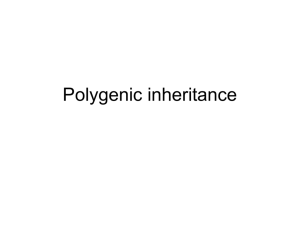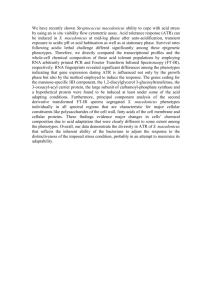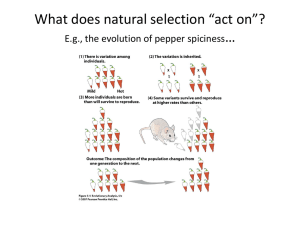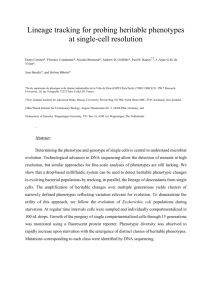Towards Cell Level Protein Interaction in Multivariate Bioimages
advertisement
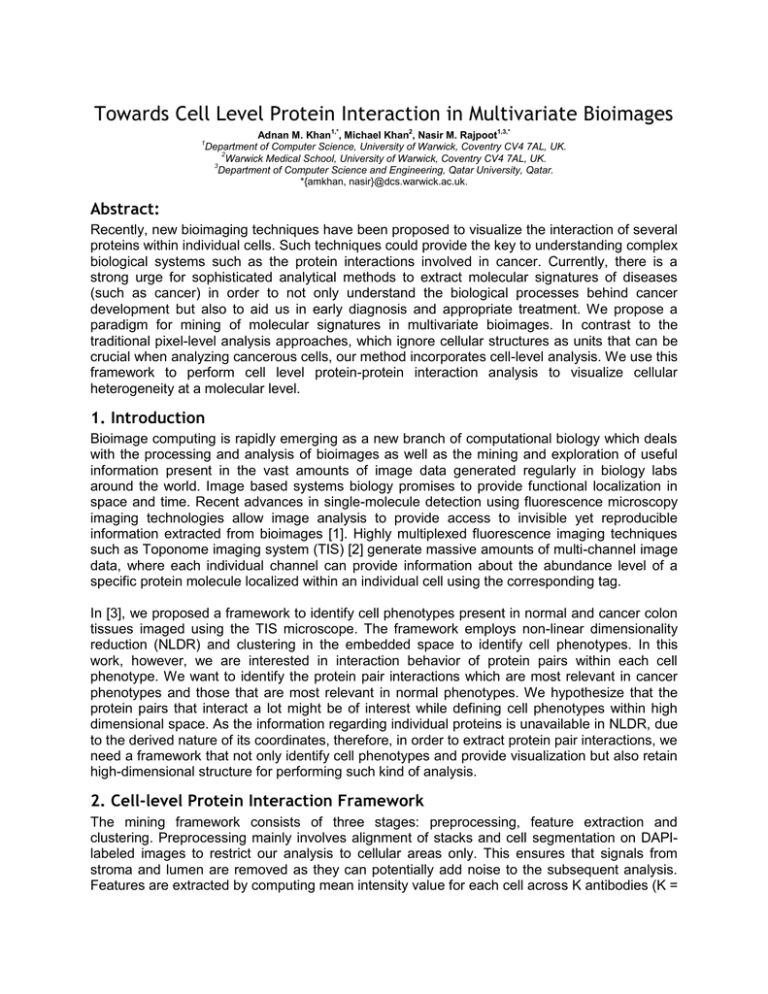
Towards Cell Level Protein Interaction in Multivariate Bioimages
Adnan M. Khan1,*, Michael Khan2, Nasir M. Rajpoot1,3,*
Department of Computer Science, University of Warwick, Coventry CV4 7AL, UK.
2
Warwick Medical School, University of Warwick, Coventry CV4 7AL, UK.
3
Department of Computer Science and Engineering, Qatar University, Qatar.
*{amkhan, nasir}@dcs.warwick.ac.uk.
1
Abstract:
Recently, new bioimaging techniques have been proposed to visualize the interaction of several
proteins within individual cells. Such techniques could provide the key to understanding complex
biological systems such as the protein interactions involved in cancer. Currently, there is a
strong urge for sophisticated analytical methods to extract molecular signatures of diseases
(such as cancer) in order to not only understand the biological processes behind cancer
development but also to aid us in early diagnosis and appropriate treatment. We propose a
paradigm for mining of molecular signatures in multivariate bioimages. In contrast to the
traditional pixel-level analysis approaches, which ignore cellular structures as units that can be
crucial when analyzing cancerous cells, our method incorporates cell-level analysis. We use this
framework to perform cell level protein-protein interaction analysis to visualize cellular
heterogeneity at a molecular level.
1. Introduction
Bioimage computing is rapidly emerging as a new branch of computational biology which deals
with the processing and analysis of bioimages as well as the mining and exploration of useful
information present in the vast amounts of image data generated regularly in biology labs
around the world. Image based systems biology promises to provide functional localization in
space and time. Recent advances in single-molecule detection using fluorescence microscopy
imaging technologies allow image analysis to provide access to invisible yet reproducible
information extracted from bioimages [1]. Highly multiplexed fluorescence imaging techniques
such as Toponome imaging system (TIS) [2] generate massive amounts of multi-channel image
data, where each individual channel can provide information about the abundance level of a
specific protein molecule localized within an individual cell using the corresponding tag.
In [3], we proposed a framework to identify cell phenotypes present in normal and cancer colon
tissues imaged using the TIS microscope. The framework employs non-linear dimensionality
reduction (NLDR) and clustering in the embedded space to identify cell phenotypes. In this
work, however, we are interested in interaction behavior of protein pairs within each cell
phenotype. We want to identify the protein pair interactions which are most relevant in cancer
phenotypes and those that are most relevant in normal phenotypes. We hypothesize that the
protein pairs that interact a lot might be of interest while defining cell phenotypes within high
dimensional space. As the information regarding individual proteins is unavailable in NLDR, due
to the derived nature of its coordinates, therefore, in order to extract protein pair interactions, we
need a framework that not only identify cell phenotypes and provide visualization but also retain
high-dimensional structure for performing such kind of analysis.
2. Cell-level Protein Interaction Framework
The mining framework consists of three stages: preprocessing, feature extraction and
clustering. Preprocessing mainly involves alignment of stacks and cell segmentation on DAPIlabeled images to restrict our analysis to cellular areas only. This ensures that signals from
stroma and lumen are removed as they can potentially add noise to the subsequent analysis.
Features are extracted by computing mean intensity value for each cell across K antibodies (K =
12), which we call the Raw Expression Vector (REV). Let be the total number of cells found in
all the stacks, then the data structure can be represented by an
matrix. Self-organizing
map (SOM) [4] is employed to learn cell phenotypes from -dimensional REV space. SOM is
chosen as it is an unsupervised learning algorithm that has the ability to learn abstractions
(prototypes) from data in some high-dimensional space without performing dimensionality
reduction. It considers each dimension of REV as a component plane - i.e. a slice in the map and generates a 2-dimensional unified distance matrix (U-Matrix) by combining component
planes in a decision function. Given component planes, each associated with antibody tag
used in this study, we calculate Pearson correlation coefficient for each pair of proteins,
localized to an individual cell phenotype, to find out top correlated protein pairs in both cancer
and normal samples.
The data used in this study is same as used in [3]. Following table shows top 3 highly correlated
protein pairs (in terms of Pearson correlation coefficient) in cancer and normal cells
respectively. Most commonly interacting proteins in cancer and normal phenotypes are different
and could be the result of changes in protein expression accompanying transformation,
adoption of a more stem cell phenotype by some cancer cells. The explanation for similar pairs
in normal and cancer (highlighted bold in table) is that there will still be normal or less
transformed clones in the cancer sample. The fact that these analyses derive from imaging
should allow us to test this hypothesis by looking at the morphology/tissue anatomy.
Nevertheless, the framework enables one to easily identify protein pairs which have significantly
higher co-expression levels in cancerous tissue samples when compared to normal colon
tissue.
Correlated
Cancer
Normal
CD166-CD57
CK19-CK20
Muc2-EpCAM
Muc2-EpCAM
CD133-CD57
CD166-EpCAM
References
1. Danuser, G.: Computer vision in cell biology. Cell 147(5) (2011) 973-978.
2. Schubert, W., Bonnekoh, B., Pommer, A., Philipsen, L., B• ockelmann, R., Malykh, Y., Gollnick, H.,
Friedenberger, M., Bode, M., Dress, A.: Analyzing proteome topology and function by automated
multidimensional fluorescence microscopy. Nature biotechnology 24(10) (2006) 1270-1278.
3. A. M. Khan, S.-e.-A. Raza, M. Khan, N. M. Rajpoot, Cell Phenotyping in Multi-Tag Fluorescent
Bioimages,Neurocomputing (Submitted).
4. T. Kohonen, Self-Organizing Maps, Springer, Berlin Heidelberg, 1995.
